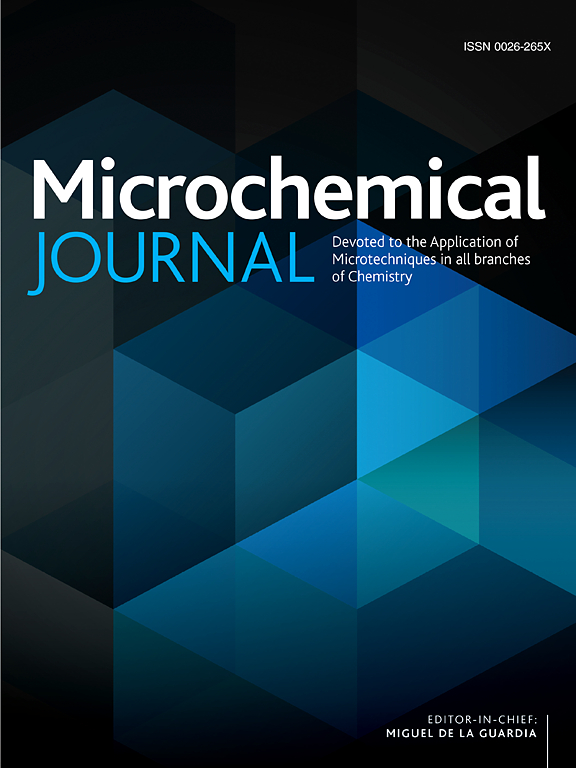A smartphone-assisted fluorescent sensor using Eu/Tb-MOF nanorods for ultrasensitive and visual monitoring of carbendazim in food samples
IF 4.9
2区 化学
Q1 CHEMISTRY, ANALYTICAL
引用次数: 0
Abstract
Foodborne residue of carbendazim (CBZ) poses a major threat to human health. Here, we rationally designed a smartphone-assisted fluorescent sensor based on bimetallic-organic framework (Eu/Tb-MOF) for ultrasensitive and visual monitoring of CBZ. The Eu/Tb-MOF nanorods fabricated using Eu3+/Tb3+ as metal nodes and homobenzoic tricarboxylic acid (H3BTC) as organic ligand exhibit superior optical properties. After adding CBZ, the strong orange fluorescence of Eu/Tb-MOF nanorods was suppressed by the inner filter effect (IFE). The linear ranges of the fluorescent sensor were 0.02–15 and 15–80 µg/mL, with a detection limit as low as 7.09 ng/mL. The analyses of CBZ residue in tomato and orange samples showed satisfactory recoveries of 98.93 %–101.97 % and low relative standard deviations of 0.87 %–3.44 %, verifying the practicality of the probe for CBZ. Notably, a simple and portable smartphone-assisted sensing platform based on the Eu/Tb-MOF nanorods was successfully constructed for quick, visual, and real-time monitoring of CBZ residue. This work provides an efficient onsite analytical method for assessment and warning-early of CBZ to safeguard food quality.

一种智能手机辅助荧光传感器,使用Eu/Tb-MOF纳米棒对食品样品中的多菌灵进行超灵敏和视觉监测
多菌灵(CBZ)食源性残留对人类健康构成重大威胁。在此,我们合理设计了一种基于双金属有机框架(Eu/Tb-MOF)的智能手机辅助荧光传感器,用于CBZ的超灵敏和视觉监测。以Eu3+/Tb3+为金属节点,均苯甲酸三羧酸(H3BTC)为有机配体制备的Eu/Tb-MOF纳米棒具有优异的光学性能。加入CBZ后,Eu/Tb-MOF纳米棒的强橙色荧光被内滤效应(IFE)抑制。荧光传感器的线性范围为0.02 ~ 15和15 ~ 80µg/mL,检出限低至7.09 ng/mL。结果表明,该探针在番茄和橙子样品中CBZ残留量的回收率为98.93% ~ 101.97%,相对标准偏差为0.87% ~ 3.44%,验证了该探针测定CBZ的实用性。值得注意的是,成功构建了基于Eu/Tb-MOF纳米棒的简单便携式智能手机辅助传感平台,用于快速、可视化和实时监测CBZ残留。本工作为CBZ的现场评估和预警提供了一种有效的分析方法,以保障食品质量。
本文章由计算机程序翻译,如有差异,请以英文原文为准。
求助全文
约1分钟内获得全文
求助全文
来源期刊

Microchemical Journal
化学-分析化学
CiteScore
8.70
自引率
8.30%
发文量
1131
审稿时长
1.9 months
期刊介绍:
The Microchemical Journal is a peer reviewed journal devoted to all aspects and phases of analytical chemistry and chemical analysis. The Microchemical Journal publishes articles which are at the forefront of modern analytical chemistry and cover innovations in the techniques to the finest possible limits. This includes fundamental aspects, instrumentation, new developments, innovative and novel methods and applications including environmental and clinical field.
Traditional classical analytical methods such as spectrophotometry and titrimetry as well as established instrumentation methods such as flame and graphite furnace atomic absorption spectrometry, gas chromatography, and modified glassy or carbon electrode electrochemical methods will be considered, provided they show significant improvements and novelty compared to the established methods.
 求助内容:
求助内容: 应助结果提醒方式:
应助结果提醒方式:


